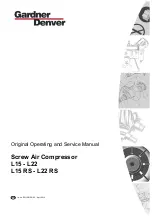
87
7. Operation and trouble shooting
7.1 Compressor start-up
PRE-START CHECKING Table below shows the required procedures and checkpoints before starting-up the
compressor during commissioning or initial operation of the unit.
Items
Things to be checked
States or standard values
1. Accessories
1. Oil level
2. Oil heater
3. System valves status
4. Solenoid valves
5. Capillary
1. Higher than the middle line of oil level sight glass
2. Should be kept energizing after compressor shut
down.
3. Opened
4. Fixed
5. No serious distortion or damaged
2. Electrical system
1. Voltage of main power
2. Voltage of control circuit
3. Insulation resistance value of the
motor between phase to phase and
phase to ground.
4.
terminal connection.
5. Grounded
6. Capacity of electrical accessories
7. Settings of switches, sensors and
controllers.
Electricity voltage should be kept within 5
to
the rated voltage, instant maximum voltage drop
while starting should be less than 10% to the
rated voltage.
If there is other demand, contact HANBELL.
3. Insulation resistance value should be above
5M
.
4. Power terminals are firmly fixed on terminal block
and well insulated. Keep wire cables away from
heat source and sharpened metal. Power
terminals are fixed firmly and well insulated.
Terminal screw and block are both required.
5. (Ruled by the local Electricity Regulations.)
6.
designer.)
7.
designer.)
3. Piping system
1. Outer piping system
2. Leakage test
3. Bolts to fix the compressor.
1. Fixed firmly.
2. No leakage.
3. Fix the compressor tightly.
4. Safety devices
1. Motor coil sensor (thermister)
2. Discharge sensor (thermister)
3. Controller
1. Connected in series with discharge sensor to
controller.
2. Connected in series with motor sensor to
controller.
3. Closed circuit with N.C. & N.O.
Note:
1. Don
’t start compressor under vacuum.
2. Check the rotating direction of screw compressor by checking its suction and discharge pressure. The correct
rotating direction is: suction pressure drops immediately and the discharge pressure increases at the same
time.
3. It is necessary to pay more attention to the auxiliary facilities while the chiller is commissioning at the job-site
and the periodic maintenance after the initial start-up.
4. Danger or severe damage to compressor is possible if the compressor is flooded with oil during standstill.
5. Check that all the settings on each pressure switch are correct.
6. Oil foaming can be generated during starting phase, but it should reduce when the compressor is under stable
Summary of Contents for RC2-100AF
Page 6: ...5 2 2 Compressor outline ...
Page 7: ...6 ...
Page 8: ...7 ...
Page 9: ...8 ...
Page 10: ...9 ...
Page 11: ...10 ...
Page 12: ...11 ...
Page 13: ...12 ...
Page 14: ...13 ...
Page 15: ...14 ...
Page 16: ...15 ...
Page 17: ...16 ...
Page 18: ...17 ...
Page 19: ...18 ...
Page 20: ...19 ...
Page 21: ...20 ...
Page 22: ...21 ...
Page 23: ...22 ...
Page 24: ...23 ...
Page 25: ...24 ...
Page 26: ...25 ...
Page 27: ...26 ...
Page 85: ...84 Horizontal External Oil Separator OS80 Horizontal External Oil Separator OS100 OS125 OS150 ...
















































